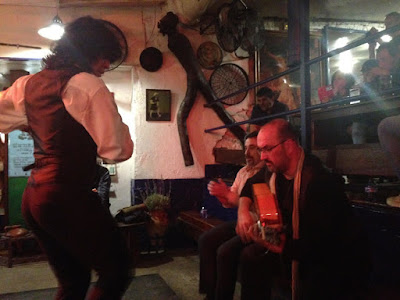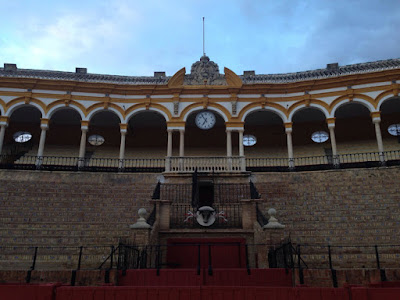As promised, and with Semana Santa coming up, I thought now would be a great time to make a post on Andalusian culture! In a previous post, I discussed the landscapes and geography of our region, so now it is time to talk about culture, and what makes Andalusia such an incredible place to live! There is no way for me to cover all of the aspects of Andalusian culture in one post, but here are some interesting things that I love about this beautiful region in southern Spain!:
Flamenco!
This dance originated in Sevilla, so we live in one of the most amazing places to see a flamenco show! It is an incredibly passionate dance involving a dancer, male or female, as well as a guitar player and a singer. They work together to create breathtaking shows that are enjoyed by locals and tourists alike. It is truly an incredible thing to witness, and if you grew up in Sevilla, chances are you know the flamenco clap! I teach 4 year olds that have begun clapping the intricate flamenco rhythm in the middle of class!
Watch an example of a flamenco performance here:
Tapas!
The
style of eating in Andalusia is very different than many other cultures,
and it is especially something that I notice as an American. American
portions are large and meal times are fairly short. In Andalusia, it is
typical to order a variety of small plates, or tapas, to share among
friends. You can enjoy them over the course of a longer period of time,
even as long as a couple of hours, and pair them with a caña or a small,
ice cold beer. Typical tapas include plates of cold meats like
traditional jamón and chorizo, slices of aged cheese, Spanish tortilla,
spinach with garbanzo beans, a cold and thick tomato soup called
salmorejo, croquetas, and toast with olive oil and a slice of Iberian
ham, to name a few.
Way of Life
I
could do a whole post just on this topic! The way of life in Andalusia
is much more laid back and relaxed than I am used to as an American.
People take more time to enjoy longer meals or a nice long stroll around
town with family for exampe, and generally seem less rushed throughout the day. The
siesta plays a big role in Spanish culture, and in Sevilla,
many businesses shut down daily between the hours of around 2pm and 5pm
depending on the business, so that workers can enjoy lunch, down time,
and maybe even a nap before coming back to work for afternoon hours.
Speaking
of meal times, in Andalusia there are 5. This was very difficult for me
to get used to and is still challenging to navigate sometimes, as
someone that is used to 3 bigger meal times. These are the typical meal
times in Sevilla:
Desayuno (Breakfast): 7am-9am: Typically bread with oil, maybe paired with ham or tomato
Almuerzo (Mid-morning
snack): 10:30am-12:30pm: This is all children eat while at school.
Typically a sandwich or milkshake brought from home.
La Comida (Lunch):
2pm-3:30pm: This is the biggest and most important meal of the day.
Children leave school at 2 and this meal is typically enjoyed at home
during siesta hours or out at restaurants in the sun with friends or
family.
Merienda (Afternoon
snack): 5:30pm-7:30pm: This is a snack to enjoy between lunch and
dinner. I teach classes that end at 6pm, and parents are always waiting
for their children with a merienda wrapped in foil. Merienda will
usually be a sandwich or maybe a chocolate pastry. Merienda time
for adults might be a coffee and a pastry with friends in a plaza, a
great time to socialize and enjoy the afternoon breeze.
Cena (Dinner):
8:30pm-10:30pm: This is a typical time to go out and enjoy some tapas,
or enjoy dinner at home. A lot of Americans are not used to how late
dinner is here, we might not know about merienda so we get hungry and want
to eat much earlier, and it is difficult to find restaurants that serve
food at the time we want to eat. Enjoying a later dinner can be a fun
way to spend time with loved ones and try some tapas together!
Bullfighting
Many
people have different views on bullfighting, but regardless of your
opinion, it is an important part of the Andalusian culture. The bullring
in Sevilla is a beautiful building with so much history, and the dress
of matadors is a common image in the minds of people when they think of
Spanish culture. I toured the bullring recently and it was fascinating
to learn about this unique and integral part of the culture in Sevilla.
Architecture
This
is one of my favorite aspects of Andalusian culture. The beautiful
buildings lined with vibrant colored tile and paints, as well as
ornately constructed landmarks such as the Cathedral of Sevilla provide a
remarkable backdrop for life in southern Spain. Every building is
decorated and maintained with such beauty, I am constantly amazed at the
artistry and care that goes into each detail of the architecture here.
Holidays
I
still have not experienced the much anticipated holidays of Semana
Santa, or Holy Week/ Easter, and Feria de Abril, or the famous Fair in
April that takes place each year in Sevilla. However I was here for
Christmas to experience mappings, or Christmas light shows, and I have
seen smaller versions of the pasos that occur during Semana Santa!
Andalusia is an incredible place to experience cultural events and
holidays all throughout the year, and I am so happy to be a part of some
of these traditions this year! Each year for Feria, a new colorful
poster is made featuring a woman in a flamenco dress as well as typical
symbols of the culture. You can see these all throughout the city, on
the walls or even being sold in smaller versions as post cards!
These
are only a few of the aspects of Andalusian culture that make it an
amazing place to live and discover. I hope you enjoyed my explanation of
Andalusia through the eyes of an American, and maybe learned something
new! Please let me know if there is anything you would add to this list,
or anything else you would like to know about this breathtaking corner
of the world!













No comments:
Post a Comment